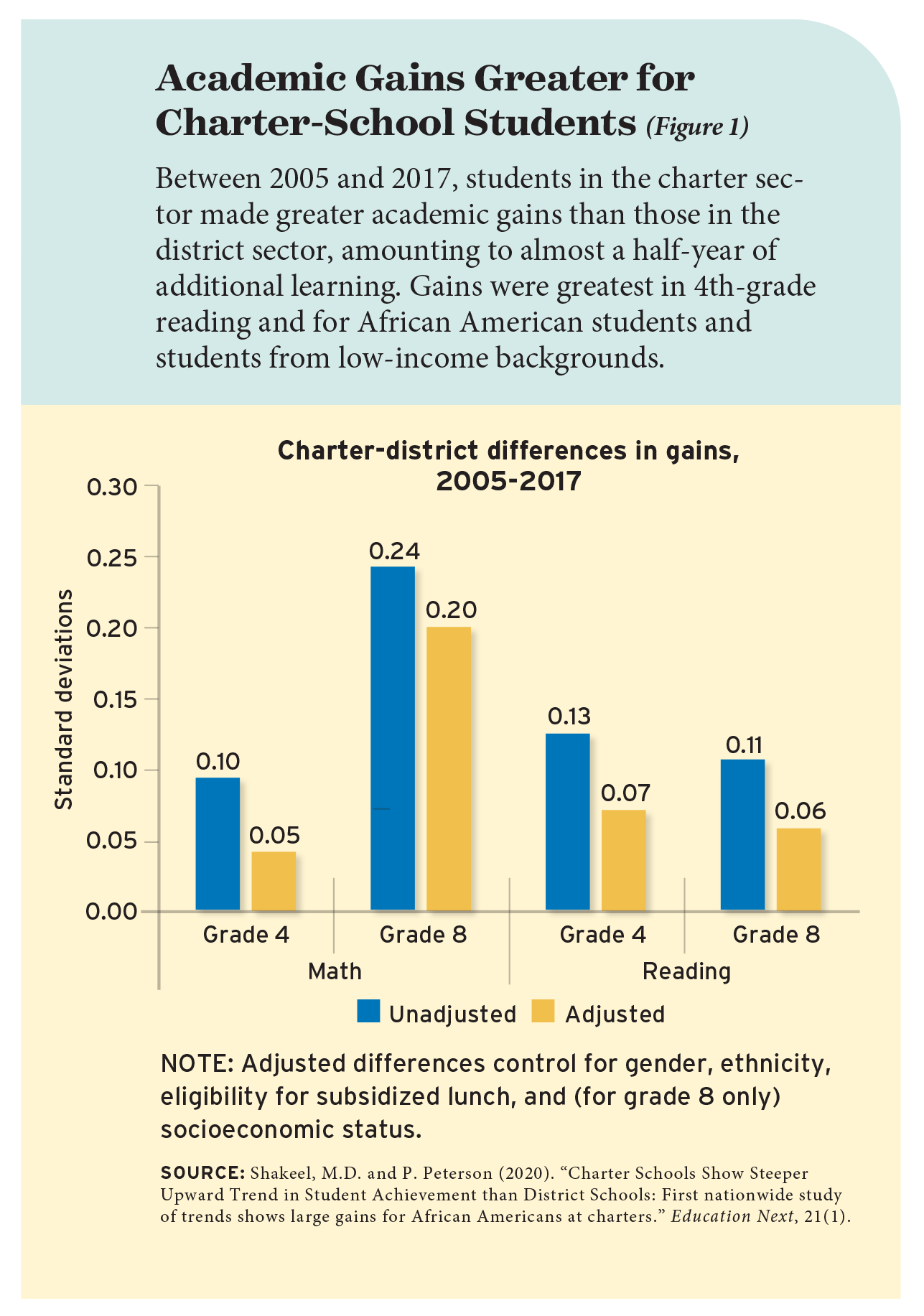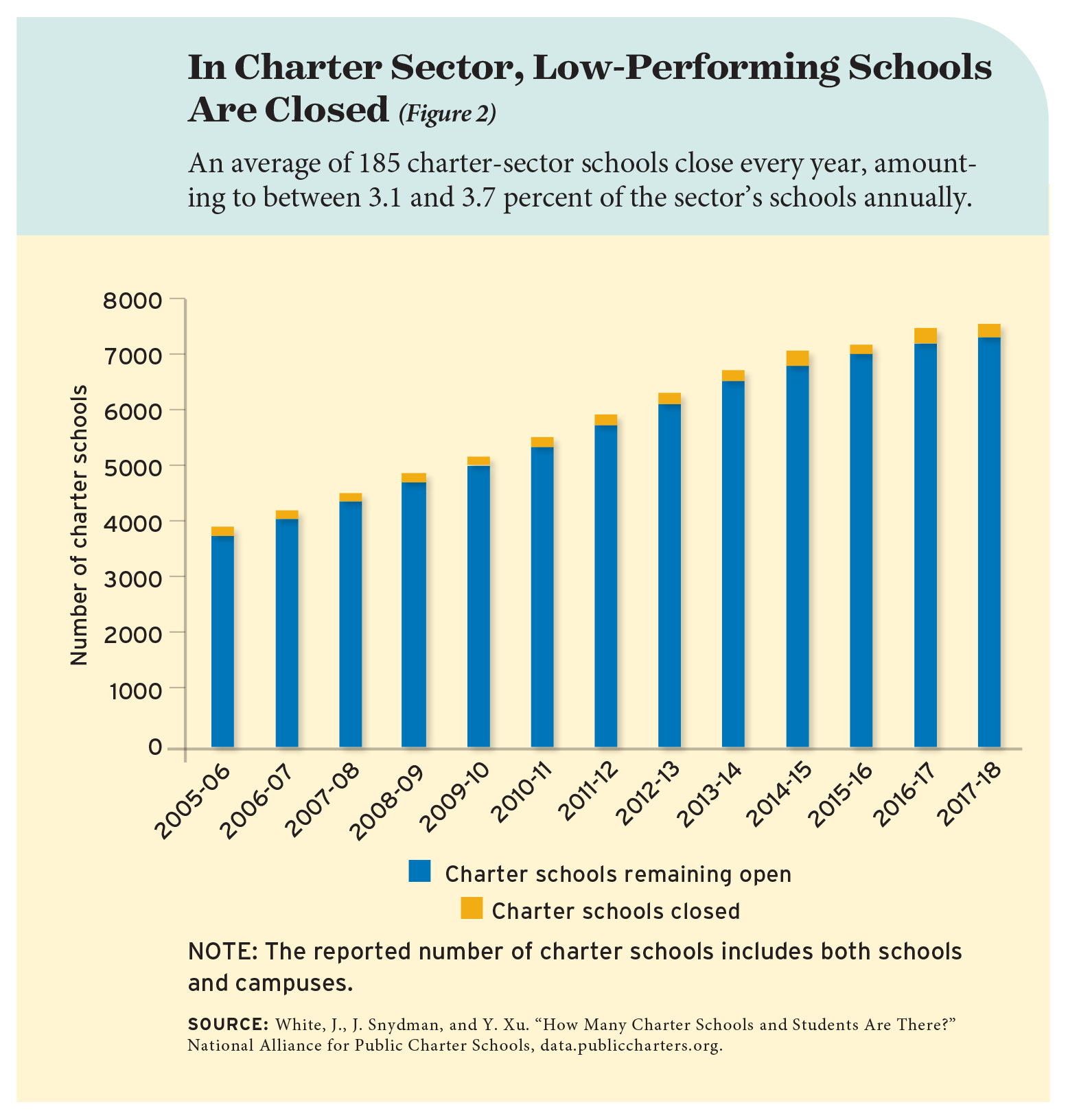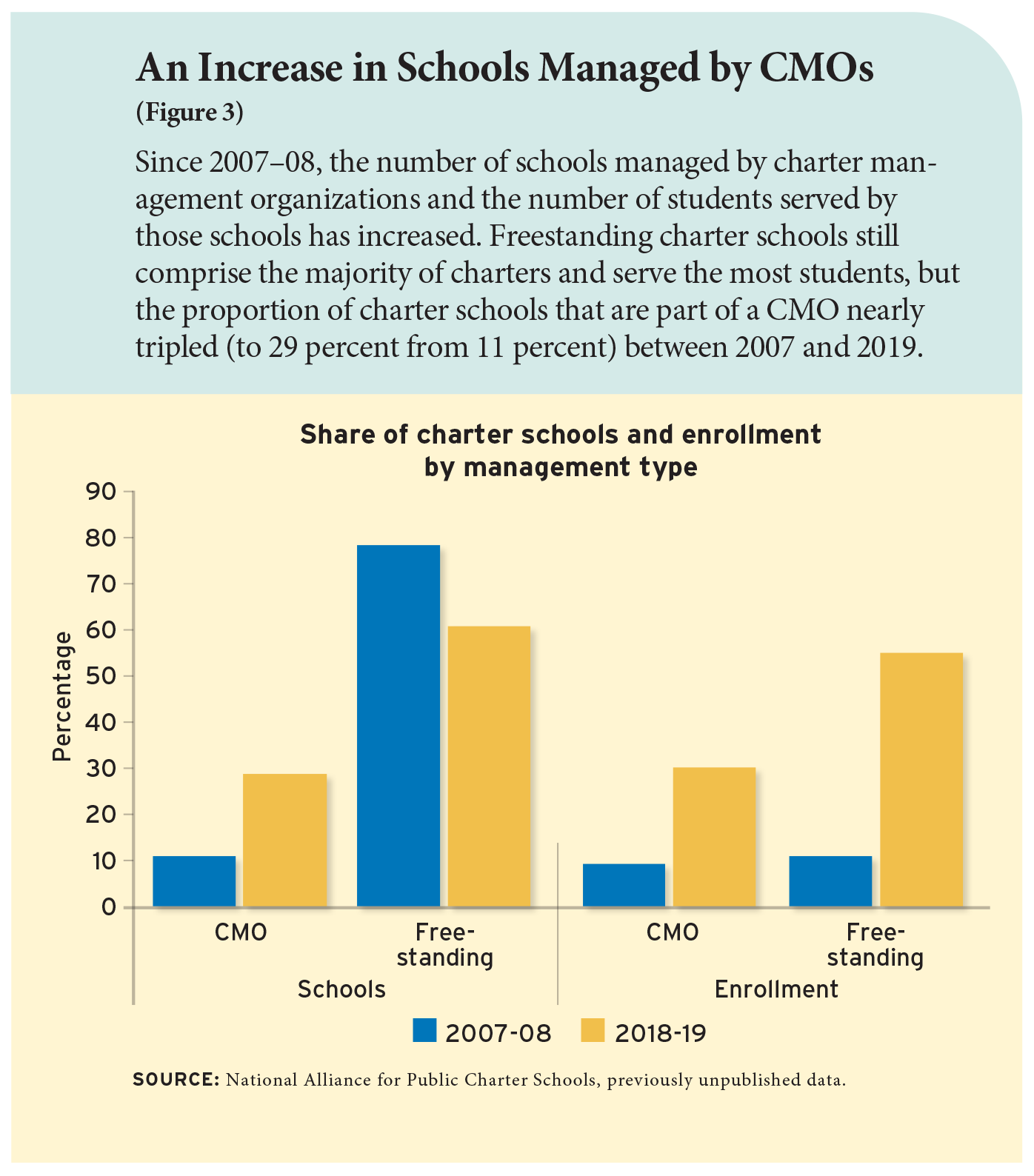 For years, media attention to charter schools has focused on the horse race: which schools are better, charter schools or district schools?
For years, media attention to charter schools has focused on the horse race: which schools are better, charter schools or district schools?
What if one were to tweak this question and ask instead: which type of school shows greater capacity for improvement, and what can educators and policymakers learn from the answer?
For some time, research has indicated that charter schools, on average, provide a superior education to students living in poverty, Black students, and Hispanic students. Now, research also shows charter schools are improving at a faster rate than district schools.
For our most disadvantaged students, charter schools are not only out in front, but they are also widening their lead.
That is great news for the children enrolled in charter schools, but no consolation to those who are not. To accelerate the achievement of all children in all types of schools, it may help to take a closer look at why one group of public schools (charter) is improving faster than another (district).
The answer is twofold:
- The combination of choice and flexibility provides charter schools with the incentive and the ability to implement practices that lead to better results.
- The charter sector has taken decisive actions based on those results, closing low-performing schools and replicating those that are succeeding.
These two factors work in tandem and reinforce each other to drive improvement; one without the other would not likely produce the same level of progress.
States began enacting charter-school laws 30 years ago, in part to create a “laboratory” for learning about effective innovation and improvement that could be transferred to other public schools. Three decades in, that knowledge is available and, if we do learn from it and apply it throughout public education, it can be used to accelerate learning for all children.

Performance Data
Daneesh Shakeel and Paul Peterson recently published research examining the changes in student performance at charter and district schools on the National Assessment of Educational Progress from 2005 to 2017 (see “Charter Schools Show Steeper Upward Trend in Student Achievement than District Schools,” research, Winter 2021).
Controlling for differences in students’ background characteristics, they found that student cohorts in the charter sector made greater gains than did those in the district sector (see Figure 1). “The difference in the trends in the two sectors amounts to nearly an additional half-year’s worth of learning,” the authors wrote. “The biggest gains are for African Americans and for students of low socioeconomic status attending charter schools.”
In 2013, Stanford University’s Center for Research on Education Outcomes, known as CREDO, reached a similar conclusion related to research the center had done four years earlier. “When compared to the 2009 results, the 2013 findings indicate overall improvement in learning gains for students at charter schools relative to their traditional public school peers in both reading and math,” the center reported.
Here too, the differences were most pronounced for low-income students:
“Compared to the learning gains of TPS [traditional public school] students in poverty, charter students in poverty learn significantly more in math,” the report said. “Moreover, this difference in performance has widened.” In 2009, charter students in poverty had an advantage of about 7 more days of learning in math each year than their TPS peers. In 2013, the edge was 22 additional days.
Patrick Baude and colleagues found similar results in a study of Texas charter-school performance from 2001 to 2011. “Charter school mathematics and reading value-added increased substantially relative to traditional public schools,” the researchers wrote. “This improvement is notable because there is evidence that traditional public schools were also improving on average.”
What explains the difference in these improvement rates? And what can policymakers and K–12 educators learn from this information?
The Role of Choice
Throughout the year, the principals and boards of charter schools focus on one particular set of data: the enrollment numbers for the coming school year. In the winter and spring, they look at the number of applicants and the grades to which they are applying. If demand is low, they are compelled to find ways to attract more students. In the summer, after lotteries have occurred, they project how many students will show up when school opens. In the fall, they compare actual enrollment and attendance to earlier projections.
Of course, principals at district schools also pay attention to enrollment, but not as often or in the same ways. For charters, the issue of enrollment spells constant pressure to improve.
That’s because a charter school’s enrollment has an immediate and significant impact on the school’s budget and the services it can provide. A school expecting 500 students that enrolls 490 may lose funding for that year that’s roughly equivalent to a full-time teaching position.
A district school that experiences the same enrollment shortfall would likely experience no impact at all. The district will shield that school from the revenue loss for that year and perhaps for years to come. (Those funds must come from somewhere, of course, and they come at the expense of other schools that are not losing enrollment.)
In a high-performing charter school, the incentive to achieve enrollment projections creates an organizational mentality focused on continuous improvement in every sphere: academics, culture, extracurriculars, teachers’ job satisfaction, communication with parents, and more. While some charter schools (often those that are struggling) spend big money on marketing campaigns, high-performing schools know that the most powerful marketing is parent word-of-mouth. If a school is delivering for students and families, others will learn about it and apply. If it is not delivering, people will hear about that, too.
The Power of Flexibility
Choice drives the quest for improvement in the charter sector, but choice itself does not improve teaching and learning. Rather, it is flexibility that enables charter schools to improve in ways that are less available to district schools.
One way that charters have tapped into their flexibility is by lengthening the school day and school year. Using data from the 2007–08 school year, the National Center on Time and Learning observed, “Charters, as opposed to traditional public schools, are more likely to extend their school year, offer longer days, and operate a year-round school calendar.” That year, the typical charter-school day was nearly 15 minutes longer than a day at its traditional public-school counterpart. While 23.5 percent of charter schools reported a longer school year than the conventional 180 days, 16.7 percent of traditional public schools did so. Ten percent of charter schools offered a significantly longer year of 187 days or more.
Fast forward to the National Center on Time and Learning’s 2012 report “Mapping the Field: A Report on Expanded-Time Schools in America.” Noting that the first serious proposal for expanding school time had appeared nearly 30 years earlier in the landmark report A Nation at Risk, the center’s publication underscored that “no movement ensued on the part of traditional public schools to break from the conventional calendar and/or schedule. The one notable exception to this adherence to school-time norms came from the emerging group of independent public schools known as charter schools.” Charter founders, the center’s report observed, had “crafted their schools—which had been established to be deliberately unlike the conventional—on a platform of a longer school day and/or year.”
Charter schools, which made up just 5 percent of public schools nationwide at the time of the center’s study, constituted 60 percent of all expanded-time schools.
The center also observed that it was much more common for start-up schools to adopt an expanded-time schedule than it was for an existing school to convert to the model. Nearly three-quarters (72 percent) of the expanded-time schools they identified were start-ups.
In 2015, the center’s findings on charter schools and time were even more pronounced. “The average charter school day has grown markedly over the last decade, with particular growth in the upper quartile,” the center noted in a review of research and practice.
Research indicates that more time in school generally leads to improved learning outcomes. Citing a meta-analysis of 15 studies, the National Center on Time and Learning found that additional time in school “can have a meaningfully positive impact on student proficiency and, indeed, upon a child’s entire educational experience. Such enhancement can be especially consequential for economically disadvantaged students. . . . For these millions of students, more time in school can be a path to equity.”
Of course, if extra time in school is to have this positive effect, a strong academic program is essential. As in all schools, academic excellence in charter schools is dependent on strong teachers. Research suggests that the workforce in charter schools differs from that of district schools in several important ways.
In 2012, roughly midway through the 2005–2017 timeframe studied by Shakeel and Peterson, the National Conference of State Legislatures reported that teaching looked different in charter schools in several areas:
Demographics. “Charter school teachers are more diverse; there are almost twice as many black and Hispanic teachers in these schools.” Further, “some data indicate charter school teachers are more likely to have graduated from a competitive or selective college.”
Licensure. “Fourteen states [out of 41 states with charter-school laws at that time] require only a certain percentage of charter teachers in each school to be licensed, varying between 30 percent and 90 percent. Four states and the District of Columbia have no requirement for licensure.”
Turnover. “Involuntary attrition is significantly higher in charter schools due to the lack of barriers to teacher dismissal and to a school’s possible instability.”
Collective Bargaining. “Twenty states and the District of Columbia exempt charter schools from collective bargaining agreements and only Iowa holds all charter schools to all existing school district collective bargaining agreements.”
While these teacher variables—demographics, licensure, turnover, and collective bargaining—could explain charter schools’ performance relative to district schools at any given point in time, they do not speak directly to the faster rate of charter-school improvement over time. A 2020 study by Matthew Steinberg and Haisheng Yang does. They first review prior evidence indicating that charter-school teachers improve with experience at a faster clip than district-school teachers. In their own study of Pennsylvania schools, they find that this is particularly the case for charter schools that are part of charter management organizations, whose teachers “improve more rapidly than teachers in its traditional public schools or standalone charters.”

Decisive Action
Imagine a city with 100 schools where, every year, the three or four lowest-performing schools in the city close and a handful of new schools open. The quality of the new additions ranges from weak to excellent, but in the aggregate, they are average. Over time, replacing the three or four lowest-performing schools with average schools will lead to improvement. Replacing them with above-average schools would lead to even faster improvement.
This scenario has not happened often among district schools, despite bold public policies like the No Child Left Behind Act and Race to the Top. With few exceptions, districts have resisted closing schools, even those that have persistently failed to educate children satisfactorily.
The charter sector, though, has embraced this scenario, annually closing 3 to 4 percent of its lowest performers for years. Over time, the sector has opened not only average schools, but a greater number of excellent schools—those run by charter management organizations.
According to the National Alliance for Public Charter Schools, from 2005–06 to 2017–18, the charter sector closed between 3.1 percent and 3.7 percent of its schools every year but two, with an average of 185 closures per year (see Figure 2).
Throughout that time, I led the National Association of Charter School Authorizers, which advocated for charter-school quality and accountability. In 2012, in our “One Million Lives” campaign, we called on public officials and authorizers to close a thousand low-performing charter schools by 2017 and to open two thousand new, high-quality charter schools. The goal was ambitious, since the sector had never closed 200 schools per year even once. Yet the campaign was widely embraced by the charter community, including advocates in states with many charter schools like Texas, California, Arizona, and Ohio.
In 2013, the Texas Charter School Association successfully advocated for the passage of a state law that raised performance standards for charter schools and provided for the closing of schools that failed to meet those standards for three successive years. The legislation also raised the cap on the number of charter schools allowed in the state and streamlined the renewal and replication process for successful schools. The Texas reform law embodied the charter philosophy: growing the number of high-quality schools and closing those that persistently failed to deliver for kids. During the two years leading up to the law’s passage, two charter schools had closed in Texas. In the two years following, 20 charters closed.
California’s state charter-school association also publicly pushed for high standards and the closure of charter schools that persistently failed to deliver results. Beginning in 2011, the association annually identified charter schools it recommended for nonrenewal. “We have too many persistently underperforming charters, and we need to come up with constructive suggestions to make sure there is sufficient accountability in the movement,” said Jed Wallace, president of the association.
In Arizona, DeAnna Rowe became the executive director of the Arizona State Board for Charter Schools in 2007. With over 500 schools throughout the state, Rowe said in an interview that the board had until then taken a “let a thousand flowers bloom” approach. “It was the right strategy at the time to launch and grow school choice for Arizona families, but at some point, you need to weed the garden.” The board improved its application process, a step that led to stronger start-ups and fewer closures. It also created a school-evaluation framework using guidance from the National Association of Charter School Authorizers, and used the framework to give greater latitude to well-performing schools and create improvement plans for lesser performers. The documentation that was created along the way “provided stronger evidence to close schools if it was necessary,” Rowe said.
Ohio focused on accountability and transparency. In 2015, the state enacted a law that required authorizers to be evaluated and certified by the state, made it easier to close failing charter schools, and prevented closed charter schools from gaming the system by transferring to another authorizer. Another much-needed weeding process followed. In the three years that followed, the number of charter schools in the state declined 14 percent, from 373 schools to 322. A 2020 study by Stéphane Lavertu subsequently found that students in grades 4 to 8 in Ohio’s brick-and-mortar charter schools made significant gains on state math and English Language Arts exams when compared to district students of similar backgrounds. Consistent with prior research, Black students made particularly strong progress. With accountability measures in place, the state has more recently turned its attention to supporting the replication of high-performing charter schools, allocating up to $1,750 per pupil for the creation of schools serving high-poverty communities.
By 2017, the goal of the One Million Lives Campaign was achieved, with a total of 1,080 failing schools shut down.

Smart Replication
The charter sector’s willingness to shutter poorly performing schools is matched by its commitment to replicating schools that excel, best illustrated by the work of the Charter School Growth Fund. The fund has invested more than $420 million in about 250 charter-school networks since 2010. Those cash infusions have helped open more than 625 new schools, and the charter-network segment of the sector has grown to serve 517,000 students in 2020–21 from about 140,000 in 2010.
Kevin Hall, chief executive officer of the growth fund, noted that “it wasn’t clear in the 2005–2010 timeframe that this idea would work at all. If you looked at school districts, you wouldn’t say that growing makes sense. There was not very much evidence.”
Since then, the number of CMO schools, the number of students served, and the quality of those schools have all increased. While freestanding charter schools still comprise the majority of charters and serve the most students, the proportion of charter schools that are part of a CMO nearly tripled (to 29 percent from 11 percent) between 2007 and 2019, and the proportion of charter-school students they enroll has more than tripled (to 30 percent from 9 percent), according to data from the National Alliance for Public Charter Schools (see Figure 3).
Rapid growth in the CMO segment has contributed to accelerated improvement in the charter sector overall, because CMO schools, on average, are delivering strong results. In 2017, CREDO studied academic performance by school-management type and concluded that “on the whole, . . . attending a charter school that is part of a larger network of schools is associated with improved educational outcomes for students” and that “research work has shown steady and consistent, even if gradual, improvement in charter school network performance.” CREDO also noted that nonprofit operators notched “significantly higher student academic gains” than did for-profits.
In reading, students attending a freestanding charter school were found to experience the equivalent of an additional 6 days of growth per school year, relative to traditional public schools, while students in CMO schools (nonprofit and for-profit), experienced an additional 17 days of growth.
Yet, 15 years ago, it was not at all clear that expanding and replicating charter schools would lead to high-quality outcomes. “In K–12 as a whole, scale does not necessarily translate into being better,” Kevin Hall said.
So why did it happen? The answer lies in “smart replication.”

“We sort of obsess on School One,” said Hall, “and then, ‘Is School Two as good or better than School One?’” What’s more, copying successful methods and approaches is not enough on its own. School operators “have to know why,” he said. “Why are they getting good results? What are they doing? Then there is a virtuous cycle. Can they attract talent, build their own talent? Do they codify what they’re doing so they can get better? All of those things happen in our
best performers.”
Hall and Ebony Lee, a partner at the Charter School Growth Fund, emphasize four key factors for charter-school success: talent, high expectations for students and the school team, high levels of support, and a forward-looking focus on what happens with students after they graduate.
Some large and influential charter authorizers, including the State University of New York, have also supported smart replication. Susie Miller Carello, executive director of the SUNY Charter School Institute, said her organization has tripled the number of schools under its umbrella over the past 10 years, keeping its focus on accountability and devoting time to learning about successful approaches to scaling.
“We went from ‘one good school at a time’ to ‘one good school as a proof point’ and being willing to support the replication of that school,” Carello said. “We talked with venture capitalists about how they determine if there is a good company they want to take on. We talked about the markers of being able to scale. You have a good program; can you convey it with fidelity to the next one or the next three? So now we give multiple charters at a time. We are venture bureaucrats.”
The charter sector’s approach to accountability and replication has had its critics, including some in the charter community itself. Some believe that authorizers have overemphasized standardized tests that define student success too narrowly and inhibit truly innovative educational models. There has been a backlash against “no excuses” models that produce high test scores but often rely on strict disciplinary systems in doing so. Companies that run virtual charter schools doubled down on this argument, maintaining that parent demand, not test scores, is the only valid measure of school quality.
Others have faulted wealthy donors for fixating on growing a relatively small number of charter networks that are disproportionately led by white founders from elite universities and from outside the communities their schools serve. Civic leaders in more than one city focused on recruiting brand-name national networks to their city rather than supporting local educators. Nonprofit organizations, variously referred to as “harbormasters” and “quarterbacks,” were launched with the purpose of saturating the market in cities picked by philanthropists with charter networks that were also selected by philanthropists.
In recent years, after the period studied by Shakeel and Peterson, the charter community has reassessed its approach on these fronts, supporting a broader definition of school quality and investing in new schools that emerge from the communities they serve. The Charter School Growth Fund has been a leader on both fronts. Still, it is worth noting that the fast pace of improvement captured by Shakeel and Peterson predates these changes. Indeed, Baude’s Texas study specifically noted the positive results from schools that focused on test scores: “Our evidence suggests that the increasing share of charter schools adhering to a No Excuses philosophy contributes to observed improvements in the sector.”
While it remains to be seen whether the new, evolved charter sector will deliver the same level of results as the old, “the whole charter premise is working,” Kevin Hall said. “High performers are replicating and, methodically, low performers are closing. It’s not perfect, but over time, this is what is happening.”
* * *
The system has its flaws. Charter performance remains weak in some states, and some schools cream-skim students. Cases of financial malfeasance are still too common, and almost all virtual charter schools have delivered substandard results. Most charter-school advocates recognize these problems and are pushing for improvement, as they have done for years.
In the summer of 2005, the newly established National Alliance for Public Charter Schools, led by its founding president Nelson Smith, convened leading charter advocates from across the country at a conference on Mackinac Island in Michigan. There, the alliance released a task-force statement that read:
If chartering is to thrive, and to play a central role in delivering public education, we must elevate quality to the highest priority. We must look inward at our schools, our authorizers, our state associations, and our own beliefs and habits of mind, so that nothing—nothing—gets in the way of pursuing higher student achievement.
For the next 12 years, the period studied by Shakeel and Peterson, the charter-school community heeded this call. As a result, charter-school performance improved because of choice, flexibility, and the sector’s commitment to taking decisive action based on results. During this time, under a Republican president and a Democrat, in red states and blue, these ideas were the dominant themes in all public education. The district sector often resisted them, the charter sector often embraced them, and charter schools showed the faster improvement.
More recently, though, some of these ideas, such as no-excuses models and the closure of failing schools, have been falling out of favor. Indeed, some former advocates of these concepts have turned their attention to other strategies. Public officials, education advocates, and educators of all stripes would do well to remember the lessons learned from research on charter schools: students receive a better education when we provide families with choices, when schools have the flexibility to implement proven practices, and when our system of public education opens more schools with a track record of strong results while closing those that persistently fail.
Greg Richmond is the superintendent of schools for the Archdiocese of Chicago and the founder and former chief executive of the National Association of Charter School Authorizers.
The post Choice, Flexibility, Accountability Drive School Improvement appeared first on Education Next.
[NDN/ccn/comedia Links]
News…. browse around here
